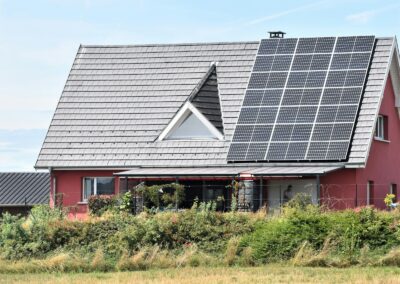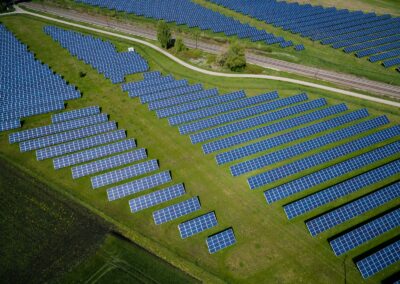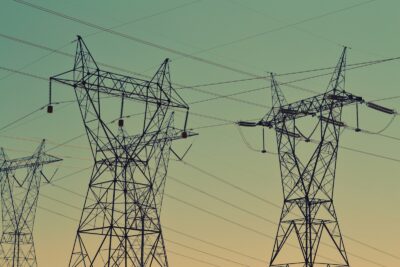Transforming Photovoltaic Cells and Renewable Technologies
Boosting Photovoltaic Cell Efficiency with Nanotechnology
The nanotechnology in renewable energy is revolutionizing the efficiency and performance of photovoltaic cells, offering promising solutions for sustainable energy generation. In technologically progressive regions like Saudi Arabia and the UAE, where solar energy is abundant, nanotechnology provides a pathway to maximizing the potential of solar power. By manipulating materials at the nanoscale, scientists can enhance the light absorption, charge separation, and overall efficiency of photovoltaic cells.
One of the key advancements in this field is the development of quantum dots and nanowires, which can significantly increase the efficiency of solar cells. Quantum dots are nanoscale semiconductor particles that have unique optical and electronic properties. When integrated into photovoltaic cells, they can enhance light absorption and convert more sunlight into electricity. In Riyadh, researchers are exploring the use of quantum dots to develop high-efficiency solar panels that can operate effectively even in low-light conditions.
Additionally, nanotechnology can improve the durability and lifespan of photovoltaic cells. Nanocoatings can protect solar panels from environmental damage, such as dust, moisture, and UV radiation, ensuring consistent performance over time. In Dubai, where harsh climatic conditions can affect the efficiency of solar installations, nanocoatings are being applied to enhance the reliability and longevity of solar energy systems. By leveraging nanotechnology, Saudi Arabia and the UAE can optimize their solar energy infrastructure, contributing to sustainable energy solutions and reducing dependence on fossil fuels.
Enhancing Other Renewable Energy Technologies with Nanotechnology
Beyond photovoltaic cells, the nanotechnology in renewable energy extends to other renewable technologies, offering innovative solutions for energy storage, wind power, and bioenergy. In regions like Saudi Arabia and the UAE, where the transition to renewable energy is a strategic priority, nanotechnology can play a pivotal role in enhancing the efficiency and feasibility of various renewable energy sources.
Nanotechnology can significantly improve energy storage systems, which are crucial for managing the intermittent nature of renewable energy sources. Nanomaterials such as graphene and carbon nanotubes are being used to develop high-capacity, fast-charging batteries and supercapacitors. These advanced energy storage devices can store large amounts of energy generated from solar and wind power, ensuring a stable and reliable energy supply. In Riyadh, research efforts are focused on creating next-generation batteries that can support the region’s growing renewable energy infrastructure.
In the realm of wind power, nanotechnology can enhance the performance and durability of wind turbines. Nanocoatings and nanocomposites can reduce friction and wear on turbine blades, increasing their efficiency and lifespan. Additionally, nanosensors can monitor the structural integrity of wind turbines in real-time, enabling proactive maintenance and reducing downtime. In Dubai, where wind energy is being explored as a complementary renewable resource, nanotechnology is being integrated into wind turbine designs to optimize energy production and maintenance.
Future Prospects and Emerging Trends in Nanotechnology for Renewable Energy
The field of nanotechnology in renewable energy is rapidly evolving, with several emerging trends poised to drive future innovations. One such trend is the convergence of nanotechnology with artificial intelligence (AI) and blockchain to create smart and efficient energy systems. AI can analyze vast amounts of data from nanotechnology-enhanced energy systems to optimize performance and predict maintenance needs. In the UAE, AI-powered energy management systems are being developed to ensure the optimal operation of renewable energy installations.
Blockchain technology can provide secure and transparent platforms for energy transactions and data sharing. By integrating blockchain with nanotechnology-enhanced renewable energy systems, stakeholders can ensure the authenticity and traceability of energy production and consumption. In Saudi Arabia, blockchain-enabled platforms are being explored to streamline energy trading and distribution, promoting transparency and efficiency in the renewable energy sector.
Another promising trend is the use of the metaverse for collaborative research and development in renewable energy technologies. The metaverse, a virtual shared space, can facilitate collaboration among scientists, engineers, and policymakers, accelerating the development of innovative nanotechnology applications. In Dubai, virtual labs within the metaverse are being established to conduct simulations and experiments on nanotechnology-enhanced renewable energy systems, fostering innovation and reducing time-to-market for new solutions.
#Nanotechnology, #RenewableEnergy, #PhotovoltaicCells, #SustainableEnergy, #SaudiArabia, #UAE, #Dubai, #Riyadh, #ChangeManagement, #ExecutiveCoaching, #EffectiveCommunication, #BusinessSuccess, #ManagementConsulting, #ArtificialIntelligence, #Blockchain, #Metaverse, #GenerativeAI, #LeadershipSkills, #ProjectManagement































